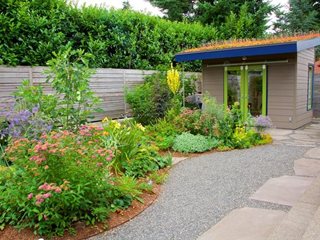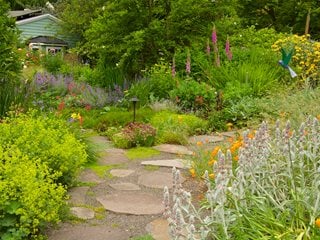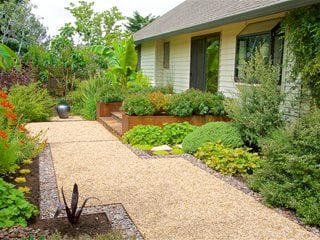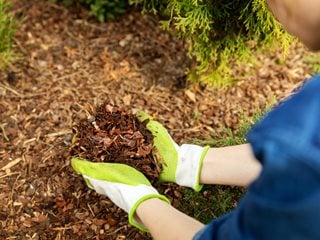Low-Maintenance Gardening Tips for a Beautiful Yard
Create a captivating landscape that doesn’t require a lot of work
Some easy-care features in this backyard include a low-maintenance perennial border and hardscape with permeable pavers and gravel. Designer: Marina Wynton. Photo: Janet Loughrey.
The appeal of having a beautiful yard is undeniable, but the upkeep can be daunting. Taking care of a traditional landscape involves hours of mowing, weeding, planting, watering, and fertilizing in order to look its best.
There are many ways to reduce maintenance chores so you can spend more time enjoying your garden and less time taking care of it. Here are some low-maintenance garden ideas to get you started.
EVALUATE YOUR YARD
Look around your yard and identify high-maintenance areas. Make a list of what you like and what is not working. Do you have a corner of the yard where plants are not thriving? Is a pond saddling you with hours of cleaning and maintenance? Do you have a collection of fussy hybrid tea roses? How much of your yard is comprised of a high-maintenance lawn?
Next, come up with ways you can reduce maintenance in those areas. This could include reducing lawn areas, using low-maintenance hardscape materials, and replacing high-maintenance plants with carefree varieties.
KNOW YOUR SOIL
Find more of Heather's tips in this video: 8 Tips for a Low-Maintenance Garden.
Whether you’re improving an existing bed or creating a new one, good soil provides the foundation for a low-maintenance landscape. Healthy plants are more resilient to pests and diseases, requiring less maintenance.
Heather Blackmore (@heatherhereshegrows) recommends having your soil tested. “A soil analysis will tell you what your soil pH is, what amendments you’re lacking, or things you don’t need. It’s really important to know what’s going on so you can have a successful garden.”
Once you’ve received the results from your soil test, improve native soil with compost and other organic materials to add nutrients, improve drainage, and support beneficial soil microbes.
LOW-MAINTENANCE GARDEN DESIGN

Low maintenance plants such as lady’s mantle, lamb’s ears and self-sowing poppies soften the pathway edges of this meadow garden. Designers: Jay Withgott and Susan Masta. Photo: Janet Loughrey.
Good design and garden planning will go a long way towards reducing maintenance. Follow these tips for a low-maintenance landscape:
Make a plan.
Whether renovating one spot in the yard or an entire landscape, do your research first. Draw up a plan and decide what kind of plants, hardscape, and furnishings you want to have. Doing your homework up front will save you time and extra expenses later on.
Add structures.
When creating a low-maintenance garden, add more permanent structures to your yard such as a patio, deck, pergola, arbor, fence, or wall. Use high-quality materials that will hold up to seasonal weather changes and look good in all four seasons. Though there is an initial investment, these features will reduce the amount of maintenance over time.
Incorporate hardscape.
Add pathways to connect different parts of the yard. Build hardscape features such as terracing, stone walls, and steps. Choose permeable materials for pathways such as gravel or pavers to allow rainwater to percolate into the ground, which will reduce runoff, help stem erosion, and conserve water.
Keep the garden layout simple.
Pick a few key elements to feature. This will keep the landscape from being too busy and harder to maintain. Choose complementary features that will unify the design.
Choose lower maintenance options.
Avoid high-maintenance features such as an elaborate pond or fountain that requires regular cleaning and maintenance. Instead, choose a simple water bowl or recirculating fountain that’s easy to clean. Replace a fast-growing privacy hedge that requires regular pruning with a fence. Composite decking material will last longer and is easier to maintain than wood, which needs regular cleaning and sealing.
Use durable garden accessories and furnishings.
Choose outdoor furniture that will stand up to the elements and regular use. More expensive well-made brands will require less maintenance and actually cost less money in the long run since they will last longer. Low-maintenance garden lighting options may include LED or solar-powered light fixtures with automated control systems. Select containers and statuary made of materials that will stand up to winter freeze/thaw cycles.

DITCH THE LAWN

A gravel walkway is surrounded by low-maintenance layered plantings of shrubs and perennials. Designer: Adriana Berry. Photo: Janet Loughrey.
Traditional lawns are high maintenance, needing a lot of water, fertilizer, mowing, edging, and thatching to look their best. Not only do lawns take a lot of time to maintain, the costs are higher as well. For minimal lawn care, you can either shrink it down or remove your lawn all together. Here are a few ideas for lawn replacements:
Add garden beds.
A perennial or mixed border can be easier to take care of than a lawn, requiring no mowing and less watering and fertilizing.
Create a rock garden.
Rock gardens can be pretty and decorative, with most rock garden and alpine plants requiring less water, fertilizer, and maintenance. Choose reliable perennial plants with similar growing needs.
Use lawn substitutes.
Replace thirsty lawns with drought-tolerant plants such as sedges, succulents, and walkable ground cover plants. Eco-friendly seed mixes containing drought-tolerant grasses, clover, herbs, or wildflowers need less watering and mowing and make a good substitute for lawns. See more eco-friendly lawn alternatives.
CHOOSE LOW-MAINTENANCE PLANTS

Cut back on garden chores by choosing shrubs that don't require pruning, such as this Spilled Wine® weigela. Photo by: Proven Winners.
High-maintenance landscapes can take the joy out of gardening when plants need to be constantly watered, fertilized, and pruned. Plant selection for low-maintenance landscapes should include varieties that are tolerant of different soils, light conditions, drought, heat, and cold. Here are some low-maintenance garden tips.
Avoid high-maintenance plants.
Reduce the amount of high-maintenance plants you have, such as wisteria, trumpet vine, or bamboo that require a lot of pruning or other maintenance. Replace fussy hybrid tea roses with carefree varieties such as Oso Easy, Knock Out, or rugosa roses. Instead of planting fast-growing laurel or privet for hedging, substitute with yew, holly, juniper, or arborvitae, which require little or no pruning.
Go native.
Choose native plants for low-maintenance beds and borders. These plants have adapted to local climate conditions including rainfall, temperature and soil, so will need little or no extra attention once established.
Create a meadow garden.
A meadow garden can be easier to maintain than a traditional lawn, requiring little or no supplemental water and fertilizer once established. This wildlife-friendly garden style mimics ecosystems found in nature and supports beneficial insects, songbirds, and other wildlife.
Plant more trees and shrubs.
Trees and shrubs require less maintenance than perennials and annuals. Choose varieties that don’t require a lot of cleanup of spent flowers, hulls, or seedlings. Conifers and broadleaf evergreens add year-round structure and permanence to the landscape.
Avoid overcrowding.
Choose compact and dwarf varieties of shrubs and trees that won’t require a lot of pruning and won’t outgrow their space. This will insure that plants won’t need to be removed because they get too big. Overcrowding and lack of air circulation can lead to mildew or other diseases, requiring more maintenance to keep plants healthy.
Limit containers.
Plants in pots, hanging baskets and window boxes require regular watering and fertilizer to look their best. Instead of a lot of smaller pots, choose one or two larger decorative planters, which will also serve as focal points.
Select long-lived bulbs.
Hybrid tulips are a favorite of gardeners for their bright colors and showy blooms, but many varieties tend to peter out after a year or two. Choose long-lived tulip varieties, daffodils, crocus, glory-of-the-snow, and muscari that will naturalize in the landscape and provide many years of low-maintenance color.
Choose resilient plant varieties.
For an easy-care garden, plant trees, shrubs and perennials that are resistant to pests and diseases, and are deer-resistant.
Plant for longevity.
Include long-lived perennials, shrubs, and trees that seldom need to be replaced. Reduce the amount of annuals, which require more maintenance and only last one growing season.
Right plant, right place.
Site plants where they are most likely to thrive. Place shade lovers in areas of the yard that receive little direct sun to reduce plant stress, foliage burn, and an increased need for watering. Place sun-loving plants in spots that receive at least 6 to 8 hours of direct sun per day. Too little light can cause fewer flowers, weak foliage color, and lanky growth. Group plants together that have similar growing needs to reduce maintenance.
Get more plant suggestions: 21 Low-Maintenance Plants and 25 Low-Maintenance Shrubs for Your Garden.
MULCH
Mulching beds with compost, bark, or other organic matter will help to keep weed seeds from sprouting. It also reduces water evaporation, cutting back on watering chores and lowering water bills. And, as garden mulch decomposes, it adds nutrients to the soil, feeding plants. Reapply mulch every year or two for the best results.
Crushed rock, pebbles, river rock, or pea gravel can also be used as a more durable inorganic mulch.
Learn more: How to Mulch and Avoid Mistakes and in this video How to Lay Bark Mulch (4 Steps).
ADD IRRIGATION
For more water-efficient landscaping, an automated irrigation system eliminates the need to drag hoses around and hand water plants. Waterwise drip soaker hoses added to garden beds deliver water directly to the root zone, decreasing evaporation and water use. Drip irrigation on timers can be added to containers.
Use a drip irrigation system that comes with different zones to tailor water usage to different areas of the yard. More sophisticated automated watering systems can be regulated and adjusted on a smart phone even when you’re away from home or on vacation, making watering chores a snap.
TIME-SAVING MAINTENANCE
Develop a regular garden maintenance routine. Make a checklist of garden chores and set aside time to complete them.
Stay on top of seasonal garden tasks such as pruning and weeding, which can reduce the overall amount of time you spend on chores.
Keep garden furniture and light fixtures clean, which will help make them last longer.
RELATED:
Zen Garden Design
How to Landscape a Sloped Yard
Moon Garden Design
Front Yard Ideas & Landscaping
Backyard Ideas & Landscaping

